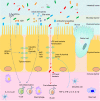Functions of Gut Microbiota Metabolites, Current Status and Future Perspectives
- PMID: 35855347
- PMCID: PMC9286904
- DOI: 10.14336/AD.2022.0104
Functions of Gut Microbiota Metabolites, Current Status and Future Perspectives
Abstract
Gut microbiota, a collection of microorganisms that live within gastrointestinal tract, provides crucial signaling metabolites for the physiological of hosts. In healthy state, gut microbiota metabolites are helpful for maintaining the basic functions of hosts, whereas disturbed production of these metabolites can lead to numerous diseases such as metabolic diseases, cardiovascular diseases, gastrointestinal diseases, neurodegenerative diseases, and cancer. Although there are many reviews about the specific mechanisms of gut microbiota metabolites on specific diseases, there is no comprehensive summarization of the functions of these metabolites. In this Opinion, we discuss the knowledge of gut microbiota metabolites including the types of gut microbiota metabolites and their ways acting on targets. In addition, we summarize their physiological and pathologic functions in health and diseases, such as shaping the composition of gut microbiota and acting as nutrition. This paper can be helpful for understanding the roles of gut microbiota metabolites and thus provide guidance for developing suitable therapeutic strategies to combat microbial-driven diseases and improve health.
Keywords: circadian rhythm; energy metabolism; gut microbiota metabolites; immune response; intestinal barrier; short-chain fatty acids.
copyright: © 2022 Liu et al.
Conflict of interest statement
Competing interests The authors declare that they have no competing interests.
Figures




References
-
- Lagier JC, Dubourg G, Million M, Cadoret F, Bilen M, Fenollar F, et al. (2018). Culturing the human microbiota and culturomics. Nat Rev Microbiol, 16:540-550. - PubMed
-
- Sekirov I, Russell SL, Antunes LC, Finlay BB (2010). Gut microbiota in health and disease. Physiol Rev, 90:859-904. - PubMed
-
- Morais LH, Schreiber HL, Mazmanian SK (2021). The gut microbiota-brain axis in behaviour and brain disorders. Nat Rev Microbiol, 19:241-255. - PubMed
LinkOut - more resources
Full Text Sources
